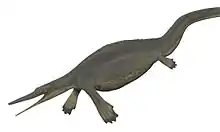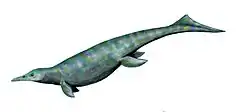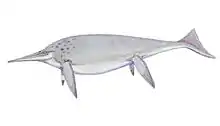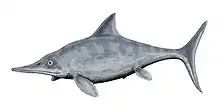Sveltonectes
Sveltonectes (meaning "agile swimmer" in Greek) is an extinct genus of platypterygiine ophthalmosaurid ichthyosaurs known from Ul’yanovsk region, western Russia.[1][2]
| Sveltonectes | |
|---|---|
| Scientific classification | |
| Kingdom: | Animalia |
| Phylum: | Chordata |
| Class: | Reptilia |
| Order: | †Ichthyosauria |
| Family: | †Ophthalmosauridae |
| Subfamily: | †Platypterygiinae |
| Genus: | †Sveltonectes Fischer et al., 2011 |
| Species: | †S. insolitus |
| Binomial name | |
| †Sveltonectes insolitus Fischer et al., 2011 | |
Description
Sveltonectes is known from the holotype IRSNB R269, an almost complete three-dimensionally preserved skeleton including a partial skull. It was collected in unnamed locality, in Ul’yanovsk, dating to the late Barremian stage of the early Cretaceous, about 126 million years ago. Another thunnosaur described from the same locality, by Bogolubow (1909), is "Ichthyosaurus" steleodon. It is a nomen dubium that is twice the size and more robust than Sveltonectes.[1]
Like some other ophthalmosaurids, Sveltonectes has a projection on the nasal bone of the skull into the naris, a prefrontal forming part of the margin of the naris and a frontal forming part of the margin of the supratemporal fenestra. Sveltonectes is unique in that it has small, sharp teeth and numerous other peculiar features such as a very primitive prootic. The distinctive shape of these teeth suggest that it had a different feeding habit than other cretaceous ophthalmosaurids. Within the Ophthalmosauridae, Sveltonectes is most closely related to Aegirosaurus.[1]
Etymology
Sveltonectes was named by Valentin Fischer, Edwige Masure, Maxim S. Arkhangelsky, and Pascal Godefroit in 2011 and the type species is Sveltonectes insolitus. The generic name is derived from sveltos, Greek for "agile", and nektes, Greek for "swimmer", and refers to its small size, streamlined skull, and powerful girdle musculature. The specific name is derived from insolitus, Latin for "unusual", in reference to the numerous unusual features of this ichthyosaur, as well as its unusual tooth morphology.[1]
References
- Fischer, V.; Masure, E.; Arkhangelsky, M.S.; Godefroit, P. (2011). "A new Barremian (Early Cretaceous) ichthyosaur from western Russia". Journal of Vertebrate Paleontology. 31 (5): 1010–1025. doi:10.1080/02724634.2011.595464. S2CID 86036325.
- Valentin Fischer; Michael W. Maisch; Darren Naish; Ralf Kosma; Jeff Liston; Ulrich Joger; Fritz J. Krüger; Judith Pardo Pérez; Jessica Tainsh & Robert M. Appleby (2012). "New Ophthalmosaurid Ichthyosaurs from the European Lower Cretaceous Demonstrate Extensive Ichthyosaur Survival across the Jurassic–Cretaceous Boundary". PLOS ONE. 7 (1): e29234. Bibcode:2012PLoSO...729234F. doi:10.1371/journal.pone.0029234. PMC 3250416. PMID 22235274.




